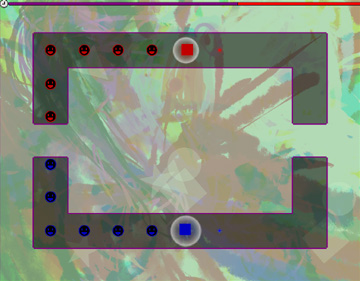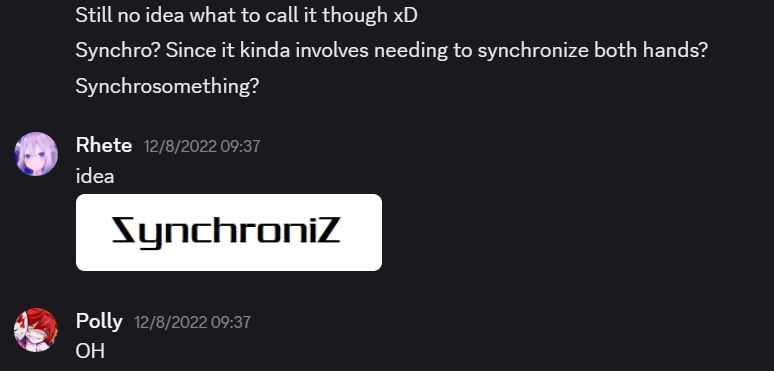

Windows Download ver. 2.02 (Latest) (48.4MB) Windows Download ver. 1.02 (Original) (50.5MB) PDF Manual (2.59MB) Download Trailer (4.51MB) Artbook by Sayara-T (39.7MB) Manual App by Rhete (4.66MB) 
Release Date: January 3rd, 2023 (Version 1.0) May 12th, 2023 (Version 2.0) Get those fingers and brain meats ready, It's time to SYNCHRONIZ! It's a mad dash against the clock and your own coordination to collect all the Smiley Boys™ before time runs out! Control both players by yourself or team up with a friend to test your synchronization!   

Created, Coded, and Level Designed by: Polly
All Background Art and Artbook Created by: Sayara-T Music by: EliteFerrex Final Boss Theme by: June Flower Four-Way Movement Code by: PBAPAPB Tested by: Toad22484, Ghosty, Iffy, Psychic_Heist, Garden, and After5 Version 2.0 Feedback and Testing: Rhete and John 
Hooo boy....SynchroniZ was...a journey. For being a game
that only took about three weeks to complete, this
game's entire history is pretty dense. This is a game
where a lot of lessons were learned from every
aspect of game development. From what to expect of your
players and their interest in your games, to being
more direct with your testers in making sure
you're communicating exactly what's meant, to learning
where and when to compromise on your vision a bit. It's
a project that both humbled and improved me as a
person who makes videogames in a lot of ways.
This game's entire gimmick was inspired by Rhete's games Xalaxer and Super Xalaxer (the latter of which I'd argue was the first time I really helped with a game's development, despite only helping plan the structure and making the SFX). I even stole the freakin' title screen music and used music from the same artist for this game's main theme! Anyway, I fell in love with the idea of controlling two player objects by yourself from the get-go. I'm a drummer, it doesn't feel all that hard to me. Big Gamedev Mistake Warning: Don't assume your potential players have the same kind of dexterity or skillset you do. Anyway, I started putting the pieces to this game together on December 6th, 2022 and had a pretty good proof of concept ready that evening. You can give it a spin or have a look below. "Blasterz" Concept Download (2.22MB) For whatever reason, the initial name this project had was "Blasterz" as evidenced by the filename, but you never do any blasting in this game at all, much to Danny DeVito's chagrin. The rooms do blow up real nice when you die, though. I was so over the moon happy with that effect, even if it's fairly processor intensive in a few later stages. A big difference between this prototype idea and the final game was that you could initially move diagonally. At first, I didn't think this would be a problem, and it would definitely make for some tricky level design ideas, but issues involving limits on how many keys can be pressed on a keyboard at the same time quickly arose. The movement was then limited to four directions using code I borrowed from GameMaker forums user PBAPAPB. In conversations shortly after that, Rhete was the one that actually coined the game's name and put together the game's logo. 
 (A few of Sayara's paintings as they appear in the game. They're transparent to work in tandem with the game's background color switcher.) After all that was settled, I just dived into making stages. Making new levels came very quickly to me and I had most of the game's initial 20 or so stages finished in about 10 or so days, give or take. This was when I started passing the game around for its first round of testing. Everyone seemed to enjoy it, but there were definitely indications by some that the game was "really hard," and at the time I didn't really interpret their feedback to mean "too" hard, just that I had made a hard game and that with enough perseverance people can beat hard games. I did a really bad job of following-up with testers on this one. I don't think anyone was being dishonest or didn't do the job right for the record, but I also never prodded more to see if maybe hints were being floated that I should tone things down a bit. And maybe I didn't wanna hear that either, because again, I thought I'd just made a hard videogame and people would play and/or want to get good enough at it to see it through to the end. Big Gamedev Mistake Warning: Don't assume people want to play your very precise and hard videogame and put in the time to get "good" at it. The final five stages were completed with relative ease and I even improvised a fun little escape sequence to lead into the final boss to tie into the climax. Again, during this time in testing, I kept hearing that the game was "really hard," but not interpreting that as "too" hard. The final boss and endgame sequence were implemented a couple days before Christmas. I tore through this part of development at a speed I just did not know I was capable of. The final boss sequence itself is fairly complicated and I had to learn a lot of new tricks, and the end sequence itself had to be built from the ground up using code and resources I'd not made yet. On top of that, it hit a personally emotional tone that made me very happy. It's something personal to me, but that context isn't needed for it to still be a cool little moment. With that, the game was officially finished. I'd sent out the 'finished' test build and resolved to release the game very early into the New Year. No major bugs during testing meant that the game was basically ready to go. That said, "Really hard..." still not interpreted as "too" hard. WAKE UP, POLLY! I cruised through the holidays feeling excited that I'd put together such a huge project. It felt like a dream game in a way. I continued the excitement by creating a silly little NES-like manual for the game just because I was so proud of what I'd put together. Release day, January 3rd, 2023 rolls around and by that evening a good number of people had played the game. There was a lot of positive feedback for it and it felt nice. I even saw a couple streams and some YouTube videos of people playing and enjoying the game. That said, there was also a lot of "really hard" that finally made the leap to "too" hard, with a lot of folks letting me know they couldn't finish the game even with stage select. The "too hard" feedback continued well after the game's release and even though the game had definitely been appreciated and some folks liked it, as time went on, I felt like I'd whiffed a lot harder on this than I initially thought. I sat and stewed on it for months, quietly letting it get to me in what I can look at now as a manner that was kind of unhealthy. A few very honest conversations with some folks made me realize the biggest thing I'd overlooked during and after SynchroniZ's release: I hadn't really considered the player's point of view much during the development of this game. Version 1 is very unforgiving. It's precise to the point of frustration and in ways that I honestly hadn't even liked in other games. There's absolutely zero leeway on the hitboxes. The normal stage timers don't allow for many tiny mistakes at all. Even though I was able to finish the game with the alotted 30 lives, I'd failed to take potential players' abilities into consideration. I think there's absolutely a time and place where you should stick to your vision regardless of feedback, but I did finally realize in the end that I'd basically made a game only for me and that I was frustrated nobody wanted to play this game I made for only me. Big Gamedev Mistake Warning: If you make a game that is only for you, don't get upset if others don't like it in the same ways you do. Once I'd put all that together, I immediately threw myself into creating a SynchroniZ Version 2.0 with a lot of feedback from John and Rhete that aimed to retain all the things that I liked about my idea, but had a decent level of forgiveness in the areas that made the game once impossible for a lot of people. Version 2.0 features a bevy of changes that brought the game in line with that vision. The hitboxes are much more generous, some trouble stages were edited to pull back on gimmicks that were too much, I replaced a couple of stages entirely, and the final boss got some slight reworks that made that part of the game make more sense. It's not compromised and it's not me selling out my original vision to try and attract more players, it's merely injecting the player perspective I usually approach my games from that was missing from the sauce when I first released this game. Version 2.0 is what this game should have been the first time, but sometimes we get full of ourselves and a little too attached to a thing we're making and can't see the forest for the trees. It's an experience I'm happy to have had because I think overall it's made me an even better developer, and I think SynchroniZ is an even better game now with the Version 2.0 build. SynchroniZ does have a couple of fun little easter eggs. On the title screen you can press down, y, down, down, y on your keyboard to enter "The @PaunchoSmith Code." I won't tell you what it does. It was inspired by a tweet from Pauncho when I previewed the manual on Twitter where he recited that code to me to write down in the "Notes" portion of the manual. Lastly, on any stage you can press the 8 key to give yourself basically infinite time. Get it? 8? Infinity symbol? Endless 8? This trick is hinted at (very badly) in the game's manual. If you look at the SZ Logo on pages 8-12, you'll find the word "eight" spelled out by rotated letters. I dunno what to tell ya, it was the end of the project and I was on empty at that point! Terrible hint! Anyway, this game's awesome and I still love it a lot as the biggest game I think I've put together by myself and I'm amazed it only took three weeks to do so. |